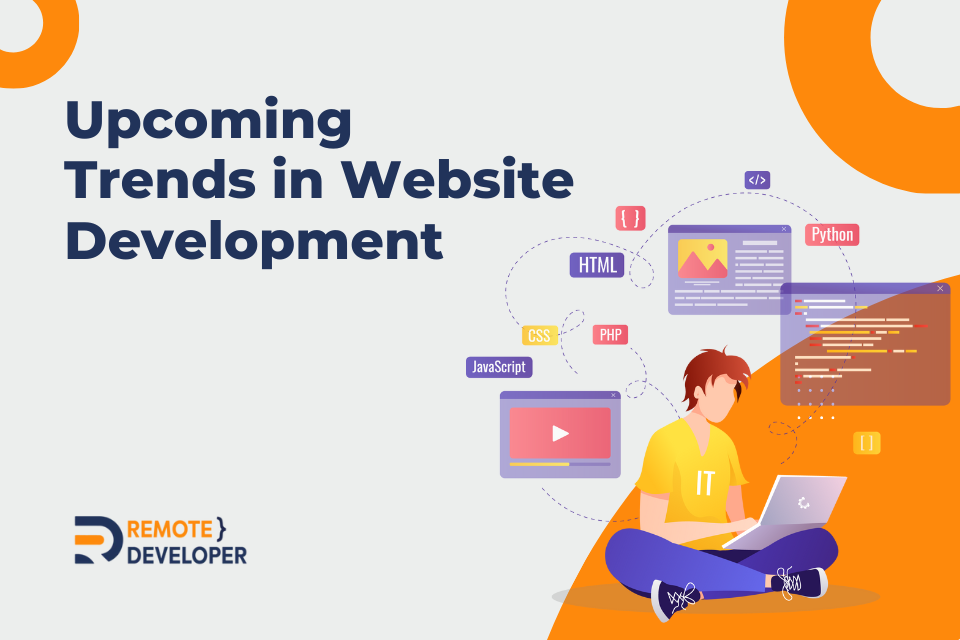Since the launch of the first website in 1991, website development has been taking amazing strides and leaps. It has evolved the internet into what millions of people know and enjoy today.
But it does not stop there! New web design trends are always coming out to transform the internet yet again.
In this article, we are sharing the upcoming trends for website development that you can apply when you revamp your own website or develop new web applications.
11 Upcoming Website Development Trends For 2023

1. Progressive Web Apps
More people are using their smartphones to surf the internet. In fact, 58.99% of the global web traffic is from mobile devices for the second quarter of this year alone.
The growing number of mobile users underlines the importance of adapting mobile-first website development such as Progressive Web Applications (PWAs).
PWA is nothing new and undoubtedly better compared. In fact, the latest iteration of this website development trend is replacing existing web applications for good.
Big companies like Google, Twitter, Uber, and Starbucks are already on this trend. The key factor is that progressive web applications provide a better user experience, with a couple more pros on the list:
- Runs offline
- Faster render time or loading speed
- Adapted for mobile devices
- Uses conventional coding languages by 2022 (HTML, CSS, JavaScript, React, and Angular)
- Reduce website development time and cost
- Seamless maintenance
2. Artificial Intelligence (AI)
Artificial intelligence has diverse uses for website applications to the point that we interact with them more often now than just a few years ago. In fact, there was an 84% jump in 2020 in marketers using AI chatbots from a meagre 29% back in 2018 alone.
Practically every business is using smarter versions to provide customer care and virtual assistants for their business websites and on popular platforms like Facebook Messenger.
With the support of machine learning (ML) and natural language processing (NLP), artificial intelligence provides plenty of benefits:
- Scalable
- Provides 24/7 service
- Reduces costs like customer service
- Personalised customer experience
- Builds better customer rapport with human-like interactions
- Continually improves based on customer insights
- Automates business processes and transactions
3. Accelerated Mobile Pages
Even with the slight downtrend in usage since 2020, accelerated mobile pages or AMP still remain the most popular mobile tech used around the world. It has been consistent in providing a lightning-fast experience for mobile users worldwide.
For website development, this open-source framework is a big plus. It allows you to create websites, emails, ads, web stories, and other forms. If you opt for Google’s AMP, it is a lot more convenient to integrate with Google’s other services:
- Search
- AMP Cache
- Analytics
- Ads Suite
4. Single-Page Application
People want easy and simple—that also applies to websites and web applications.
Enter: Single-page application, or SPA for short. It is a web application that is based on a JavaScript framework. And as the name suggests, is a single page. The best thing about the SPA is that it can update content without having to refresh the whole page.
This website development trend has been around for quite a while now and we expect that it will continue to do so. It is widely adopted in the community that big tech companies like Google, Facebook, and Twitter even use this—and with good reason too:
- Cost-effective
- Easy to create
- Reduces bounce rate
- Works even with a slow internet connection or offline
- Uses cached data
5. Voice Search
Siri and Alexa are not the only superstars! The voice search feature for smartphones and IoT devices is popular too.
Since it was first launched by Google back in 2011, voice search has become a staple feature used by many people worldwide. More so now, since virtual assistants are not only used for search queries but also integrate with everyday life with smart commands.
6. WordPress
WordPress is a content management system that powers a lot of websites we see on the internet. It is still the go-to for website development since it is easy to use and offers an accessible open-source platform. What is more, WordPress continues to improve and add more features for web developers’ convenience.
7. Motion UI
Fast and mobile-friendly is the baseline now for web design trends. Aside from that, people want more—they want an interactive experience.
Motion UI satisfies this expectation. It is a front-end framework that creates responsive websites and applications. So even if you add simple predefined motions during the website development, it will surely elevate web users’ online experience.
8. Serverless Architecture
This web design trend is built on cloud technology. Meaning, users can practically run any application without having to set up a server or even manage it.
This is a big plus for website development for a lot of reasons:
- Reduce costs for development and maintenance
- Minimise chances of system overloading
- Avoid data loss
9. Dark Mode
It is hard to pinpoint when Dark Mode was first introduced. One thing is for sure, this web design trend has quickly gained popularity in recent years—and more companies are closely following suit.
It makes sense to add this during website development. Studies show that 91.8% of people would prefer to use dark mode whenever it is available.
10. Improved Cybersecurity
Cybersecurity continues to be one of the pressing concerns, even for 2023. In recent years, news of information leaks, hackers, and personal information being sold have grown in number.
Just last year alone, 533 million Facebook users’ personal data leaked online as well as 500 million LinkedIn profiles were put for sale on a popular hacker forum. This underlines the need for better cybersecurity.
As a result, are amping up cybersecurity measures even during website development to protect sensitive and crucial information. There is also an increase in the integration of multi-factor authentication, patch management, and Security Operation (SOC) as well.
11. Mobile-Friendly Development
As mentioned earlier in this article, more than half of internet traffic worldwide is generated by mobile users. This tidbit alone backs the importance of mobile-friendly website development.
There are plenty of ways to make your website mobile-friendly. In fact, some of the web design trends we mentioned here actually fall under this umbrella already.
The point is: just make sure your website appears and functions well for both desktop and mobile devices. To ensure this, it is easier to apply a mobile-first approach.
There Are Tons Of Possibilities
It is no surprise already, some of the website development trends you see here you are already quite familiar with or already apply for your own website. The good thing is that just means you and your team are on the right track and up to date.
All of these web design trends funnel down with one general goal in mind: To make websites and website applications easy to use for a diverse range of web users.
Want to know more about website development? There are loads more to learn on our website.

